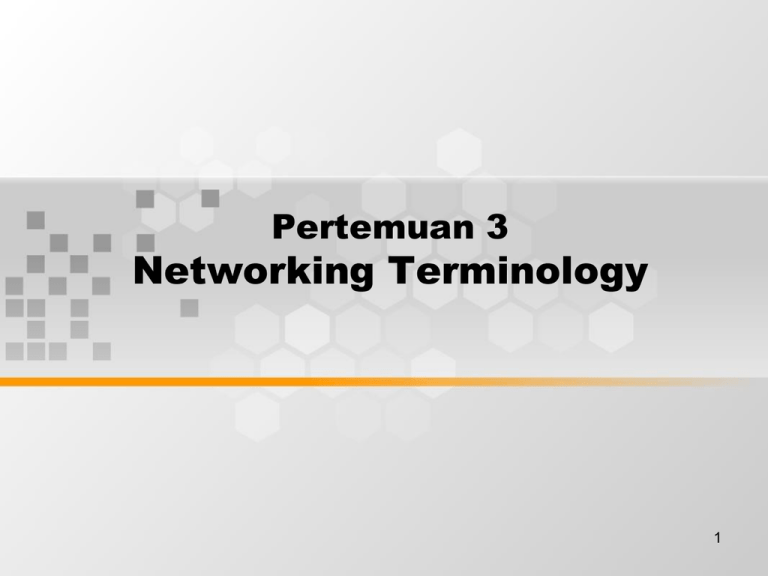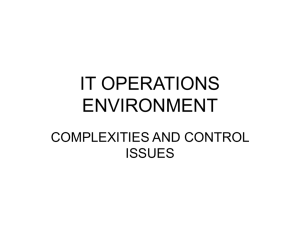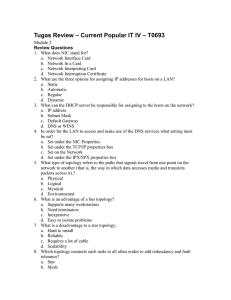Networking Terminology Pertemuan 3 1
advertisement

Pertemuan 3 Networking Terminology 1 Discussion Topics • • • • • • • • • • • • Data networks Network history Networking devices Network topology Network protocols Local-area networks (LANs) Wide-area networks (WANs) Metropolitan-area networks (MANs) Storage-area networks (SANs) Virtual private network (VPN) Benefits of VPNs Intranets and extranets 2 Data Networks 3 Data networks • • • • One early solution was the creation of local-area network (LAN) standards. Because LAN standards provided an open set of guidelines for creating network hardware and software, the equipment from different companies could then become compatible. This allowed for stability in LAN implementation. In a LAN system, each department of the company is a kind of electronic island. As the use of computers in businesses grew, it soon became obvious that even LANs were not sufficient. 4 Data networks • What was needed was a way for information to move efficiently and quickly, not only within a company, but also from one business to another. • The solution was the creation of metropolitan-area networks (MANs) and wide-area networks (WANs). 5 Network History 6 Network History 7 Network History 8 Networking Devices 9 Networking devices 10 Network Topology 11 Network topology • Network topology defines the structure of the network. • Physical topology, which is the actual layout of the wire or media. • Logical topology, which defines how the media is accessed by the hosts for sending data. • The logical topology of a network is how the hosts communicate across the medium. • The two most common types of logical topologies are broadcast and token passing. 12 Network Protocols 13 Bus Topology “A bus topology uses a single backbone segment (length of cable) that all the hosts connect to directly.” 14 Ring Topology “A ring topology connects one host to the next and the last host to the first. This creates a physical ring of cable.” 15 Token Ring • Token Ring NIC and Hub (or MAU) 16 Star Topology “A star topology connects all cables to a central point of concentration. This point is usually a hub or switch, which will be described later in the chapter.” 17 Extended Star Topology “An extended star topology uses the star topology to be created. It links individual stars together by linking the hubs/switches. This, as you will learn later in the chapter, will extend the length and size of the network.” 18 Hierarchical Topology Only one definition -> “A hierarchical topology is created similar to an extended star but instead of linking the hubs/switches together, the system is linked to a computer that controls the traffic on the topology.” 19 Hierarchical Topology Another definition -> A hierarchical design or model is one that implements a layered approach to networking. This is discussed later in CCNP courses. 20 Mesh Topology “A mesh topology is used when there can be absolutely no break in communications, for example the control systems of a nuclear power plant. So as you can see in the graphic, each host has its own connections to all other hosts. This also reflects the design of the Internet, which has multiple paths to any one location.” There are also full mesh and partial mesh topologies, both physical and logical, which will be discussed later in CCNA semester 4 (Applied Networking 3). 21 Network protocols • Protocol suites are collections of protocols that enable network communication from one host through the network to another host. • A protocol is a formal description of a set of rules and conventions that govern a particular aspect of how devices on a network communicate. Protocols determine the format, timing, sequencing, and error control in data communication. • Without protocols, the computer cannot make or rebuild the stream of incoming bits from another computer into the original format. 22 Network protocols Protocols control all aspects of data communication, which include the following: • • • • • How the physical network is built How computers connect to the network How the data is formatted for transmission How that data is sent How to deal with errors Examples • Institute of Electrical and Electronic Engineers (IEEE), • American National Standards Institute (ANSI), • Telecommunications Industry Association (TIA), • Electronic Industries Alliance (EIA) • International Telecommunications Union (ITU), formerly known as the Comité Consultatif International Téléphonique et Télégraphique (CCITT). 23 Local-area networks (LANs) Some common LAN technologies are: • Ethernet • Token Ring • FDDI 24 Wide-area networks (WANs) Some common WAN technologies are: • Modems • Integrated Services Digital Network (ISDN) • Digital Subscriber Line (DSL) • Frame Relay • US (T) and Europe (E) Carrier Series – T1, E1, T3, E3 • Synchronous Optical Network (SONET) 25 Metropolitan-area networks (MANs) • A MAN is a network that spans a metropolitan area such as a city or suburban area. • A MAN usually consists of two or more LANs in a common geographic area. • For example, a bank with multiple branches may utilize a MAN. 26 Storage-area networks (SANs) • A SAN is a dedicated, high-performance network used to move data between servers and storage resources. • SANs offer the following features: • • • Performance – SANs enable concurrent access of disk or tape arrays by two or more servers at high speeds, providing enhanced system performance. Availability – SANs have disaster tolerance built in, because data can be mirrored using a SAN up to 10 kilometers (km) or 6.2 miles away. Scalability – Like a LAN/WAN, it can use a variety of technologies. This allows easy relocation of backup data, operations, file migration, and 27 data replication between systems. Virtual private network (VPN) • VPN is a private network that is constructed within a public network infrastructure such as the global Internet. • Using VPN, a telecommuter can access the network of the company headquarters through the Internet by building a secure tunnel between the telecommuter’s PC and a VPN router in the headquarters. • A VPN is a service that offers secure, reliable connectivity over a shared public network infrastructure such as the Internet. 28 Benefits of VPNs The following are the three main types of VPNs: • Access VPNs – Access VPNs provide remote access to a mobile worker and small office/home office (SOHO) to the headquarters of the Intranet or Extranet over a shared infrastructure. • Intranet VPNs – Intranet VPNs link regional and remote offices to the headquarters of the internal network over a shared infrastructure using dedicated connections. Allow access only to the employees of the enterprise. • Extranet VPNs – Extranet VPNs link business partners to the headquarters of the network over a shared infrastructure using dedicated connections. 29 Allow access to users outside the enterprise. Intranets and extranets • • • • • Intranets are designed to permit access by users who have access privileges to the internal LAN of the organization. Within an Intranet, Web servers are installed in the network. Browser technology is used as the common front end to access information such as financial data or graphical, text-based data stored on those servers. Extranets refer to applications and services that are Intranet based, and use extended, secure access to external users or enterprises. This access is usually accomplished through passwords, user IDs, and other application-level security. 30



